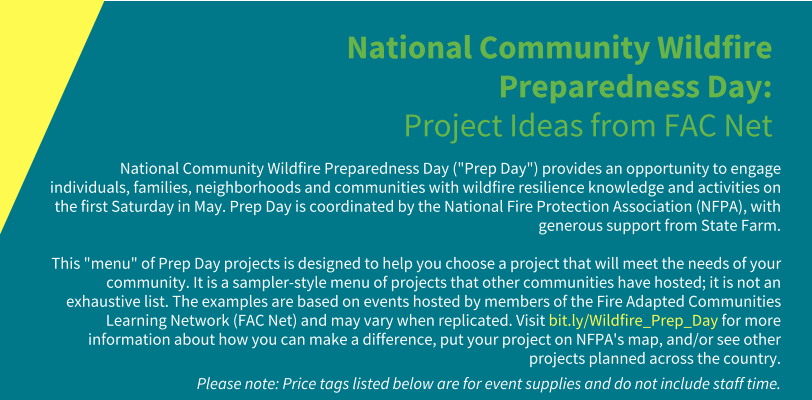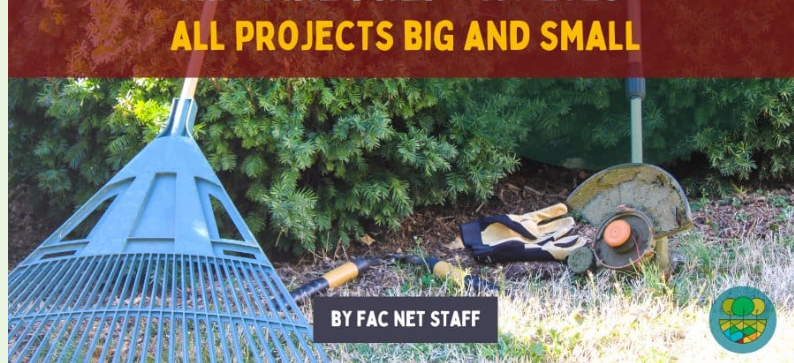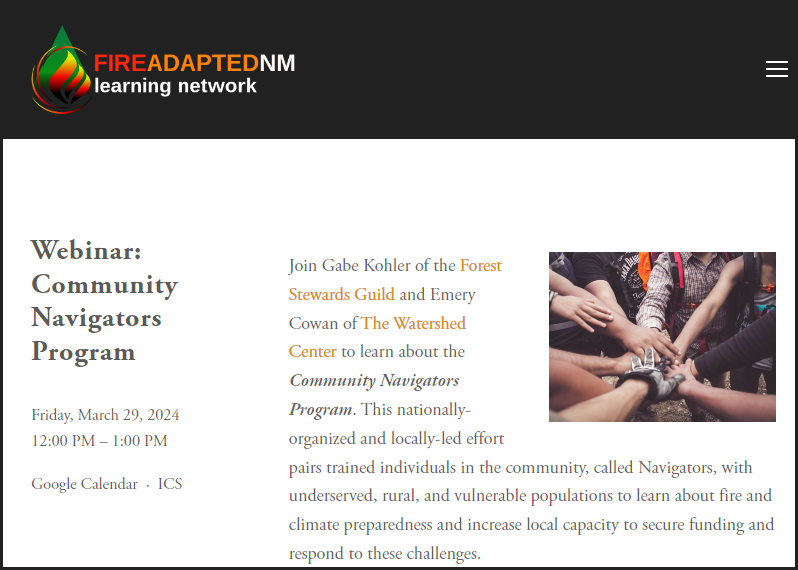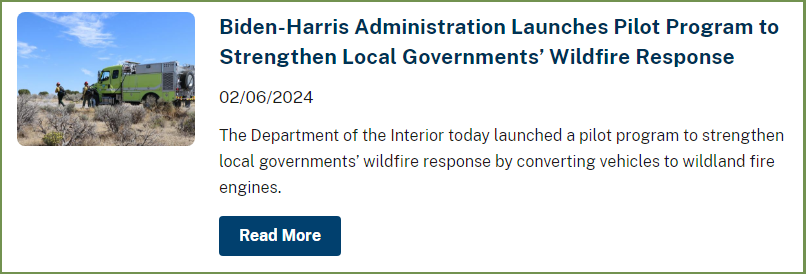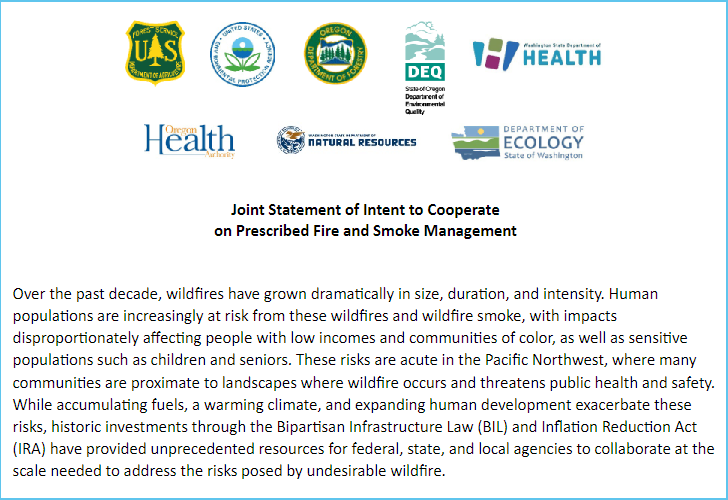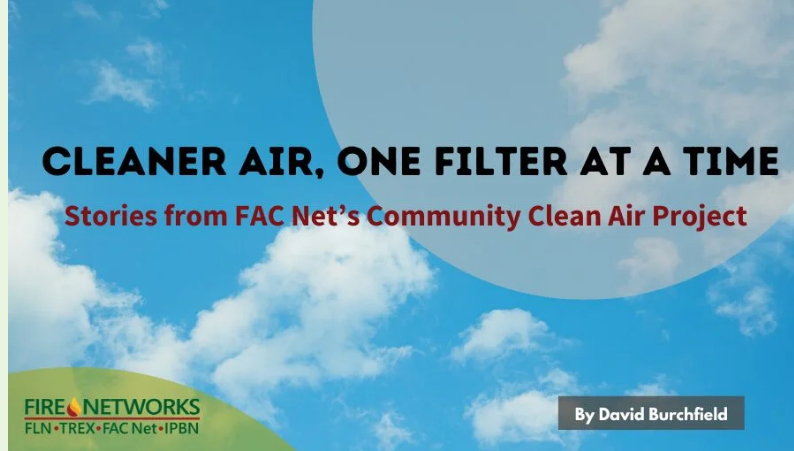Happy Wednesday, Fireshed readers!
With recent gusty winds and grass fires on the eastern plains, FACNM is looking ahead to the not-so-distant summer fire preparedness planning. Wildfire Community Preparedness Day, held annually in the United States and Canada on the first Saturday in May, is a great place to kick off with your own readiness plans. Each year, the campaign actively encourages groups and individuals living in wildfire-prone areas to come together on a single day to raise awareness and reduce wildfire risks by completing projects that can help make their homes and communities safer from wildfire. This year, the day of action will be held on Saturday, May 4. The Fireshed will be offering ideas, resources, and local opportunities over the next couple of months to help communities prepare for and get involved with Wildfire Prep Day 2024.
Today’s Wildfire Wednesday features:
Take care as we leap(year) into March!
-Rachel
The Power of Community Action in Wildfire Prep
“As wildland fires increasingly involve residential areas, communities have to take action to help mitigate the potential effects of wildfire. However, residents can be uncertain about what to do, reluctant to get involved, or unclear about the impact they can have. As resources are stretched to cope with suppression and restoration efforts,” local community members and leaders play an increasingly important role in promoting and enabling wildfire preparedness.
Collective action means working together to be prepared, vigilant, proactive, and to prioritize resilience over complacency and face the challenge of wildfires head-on. Community in wildfire preparedness is valuable for many reasons. “As residents, [community members and leaders] understand [their neighbors] and are able to encourage mitigation and preparedness in a number of ways, including:
Helping to identify important local issues and create a vision for action.
Developing a preparedness strategy that takes community members’ goals into account.
Obtaining commitment to act by communicating with other residents and building one-on-one relationships. [This emphasizes] the importance of individuals taking on responsibilities that benefit the community.
Mobilizing financial and material resources.” (Lang et al, 2006)
While individual actions to prepare homes, kids, pets, belongings, and businesses for wildfire are an essential element of fire readiness, coming together as a community to learn, assess collective risk, and reduce fire hazards can motivate and amplify the work of becoming fire adapted.
Wildfire Prep Day Ideas and Resources
Prep Day Dashboards
NFPA
Wildfire Community Preparedness Day - commonly shortened to Wildfire Prep Day - focuses on what you can do in and around your home to help protect against the threat of wildfires. The annual event is organized by the National Fire Protection Agency (NFPA) and sponsored by State Farm. To help you get ready, NFPA offers:
Shareable social media cards
View the NFPA 2024 Prep Day press release.
Another general toolkit: wildfire.gov offers additional information and resources to prepare for all stages: before, during, and after the fire.
FAC Net
Fire Adapted Communities Learning Network offers a Community Prep Day Menu with a plethora of project ideas for individuals and leaders! Those community organizers who are interested in convening a preparedness event in their neighborhood, city, or county can get inspired by these tried-and-true project ideas:
Fuels removal: secure funding and organize with your local contractors to hold a community chipper or green waste day.
Assessments: partner with an organization such as your fire department to bring existing assessment programs to your community.
Education: work with local fire ecologists, fire personnel, and businesses to host an educational day in the woods, community center, or downtown. Invite your guests to talk about fire science, discuss how fires impact businesses and tourism, and tell their personal wildfire stories.
Build awareness: partner with your local fire department to bring an engine to the neighborhood! Post up at a stop sign, local park, or entrance road to create a W.U.I. Checkpoint (Wildland-Urban Interface). This activity is modeled after D.U.I. checkpoints, with a play on words. Give vehicles information about fire preparedness as you stop them.
Mitigation fair: create an interactive fair: arrange 5-7 stations on various fire preparedness topics with a call to action - some actionable takeaway for participants - at each station. Attendees will visit different stations to learn how to safely and effectively mitigate wildfire risk on their property.
Learn more and get inspired by reading FAC Net’s 2023 Wildfire Prep Day article: All Projects Big and Small.
Assessing Community and Individual Risk
Is your community prepared for fire? How can you and your partners improve your resilience? Use the Fire Adapted Communities Self-Assessment Tool (FAC SAT) to find out! FAC SAT was created to help communities assess their fire adaptation efforts and to plan and track their capacity to live safely with fire over time. This tool can be used to assess individual neighborhoods, cities and even large counties. FAC SAT is a PDF document containing a series of questions. Completing the assessment is a four-step process. Detailed information about who should be involved and how long the process takes can be found in the FAC SAT User and Facilitator’s Guide.
Tailoring the Fire Prep Approach to Your Community
The Fire Adapted Communities Pathways Tool (Pathways Tool) helps users identify a range of fire adaptation practices and resources that research and experience indicate are more likely to work in the places they live and work.
This tool combines decades of research on community wildfire adaptation with practitioner-based knowledge and experience. It helps users identify a community, determine an initial “community archetype” and suggest fire adaptation practices, tools and approaches suited to similar communities. The Pathways Tool then helps users create a ‘pathway’ that is tailored to their community conditions. The tool is also intended to inform progress on fire adaptation across varied regions, identify the most effective programs, grants or assistance for supporting community adaptation, and to demonstrate the diverse needs for wildfire adaptation to promote equity in ongoing fire resilience work.
Learn more, access the Pathways Tool, and watch a recording of the introductory webinar.
……..
Additional Wildfire Prep Resources
The Community Wildfire Planning Center provides a number of resources for planning the Wildland-Urban Interface, including guidance for adopting defensible space ordinances, opportunities for risk assessments through programs like REALFire, links to State and National WUI planning resources, and more. Explore the CWPC website.
Events, Announcements, and Additional Resources
Webinars
Friday, March 29 from 12:00-1:00pm: Community Navigators Program
FACNM is launching its spring webinar series beginning on March 29th! Join Gabe Kohler and Emery Cowan as they introduce the national and regional intent of the Community Navigators Program and discuss how communities across the state can access this resource.
Keep an eye on the FACNM Events page to learn more and register for additional webinars in the spring series!
Recording available: The Wildland Fire Mitigation and Management Commission Report
Neil Chapman with the Flagstaff Fire Department joined the Forest Stewards Guild in mid-February to explain the formation and process enacted by the Wildland Fire Mitigation and Management Commission, including the publication and impact of the 2023 Commission Report.
Funding Opportunities
The Department of the Interior has launched a pilot project to help local government agencies convert vehicles for use as wildland fire engines. Agencies serving areas with a population of 25,000 or less are eligible to apply, with applications being accepted through March 21. See the press announcement for details and visit Grants.gov to apply.
In the News
Air Quality
Early this month the U.S. EPA strengthened the National Ambient Air Quality Standards (NAAQS) for fine particle pollution (PM2.5). They have released several fact sheets about this rule change, including “Final Updates to the Air Quality Index…”, “Implementing the Final Rule …”, and “Wildland Fire, Air Quality, and Public Health Considerations”. Last week, the EPA, USDA Forest Service and health and land management agencies in Oregon and Washington recognized the important role of prescribed fire for public health and ecosystem resilience in their “Joint Statement of Intent to Cooperate on Prescribed Fire and Smoke Management.”
For some variations on one approach to helping community members mitigate smoke exposure, see the Fire Networks blog post “Cleaner Air, One Filter at a Time: Stories from FAC Net’s Community Clean Air Project.”




